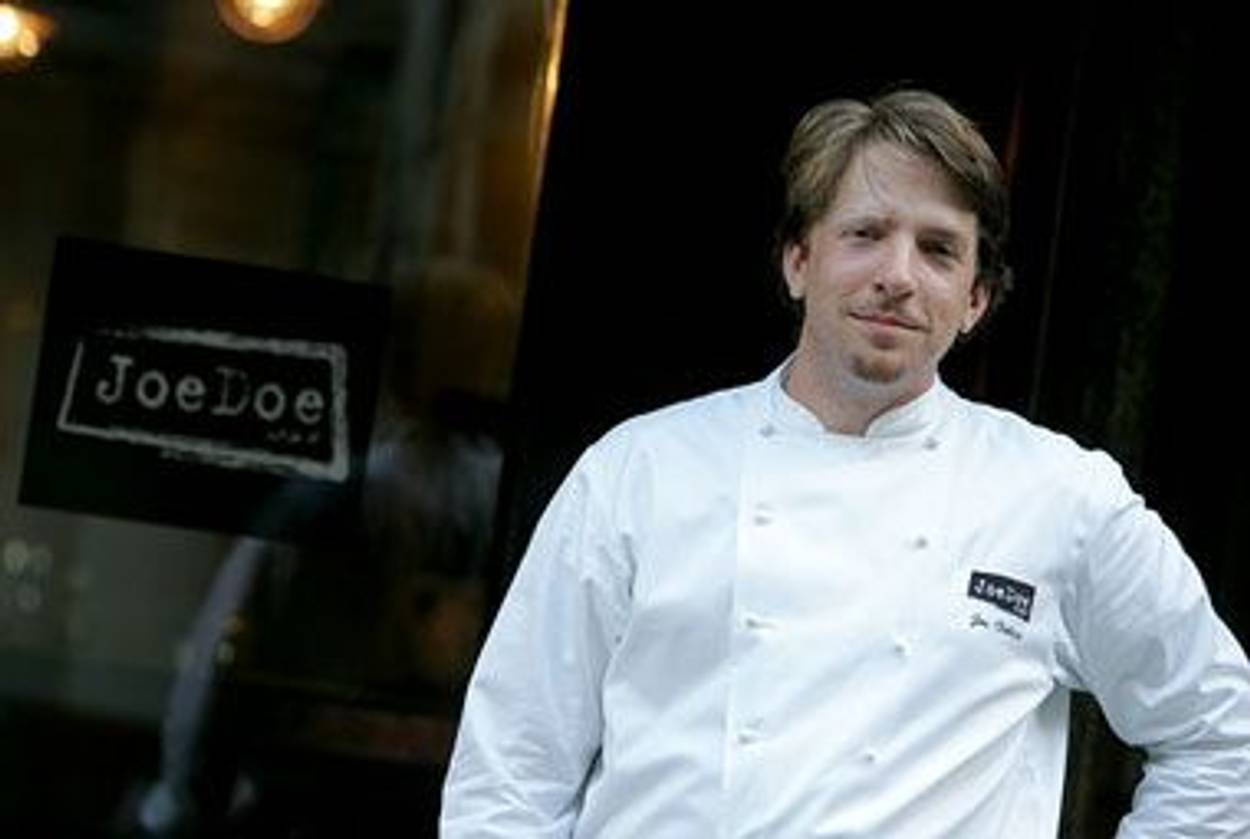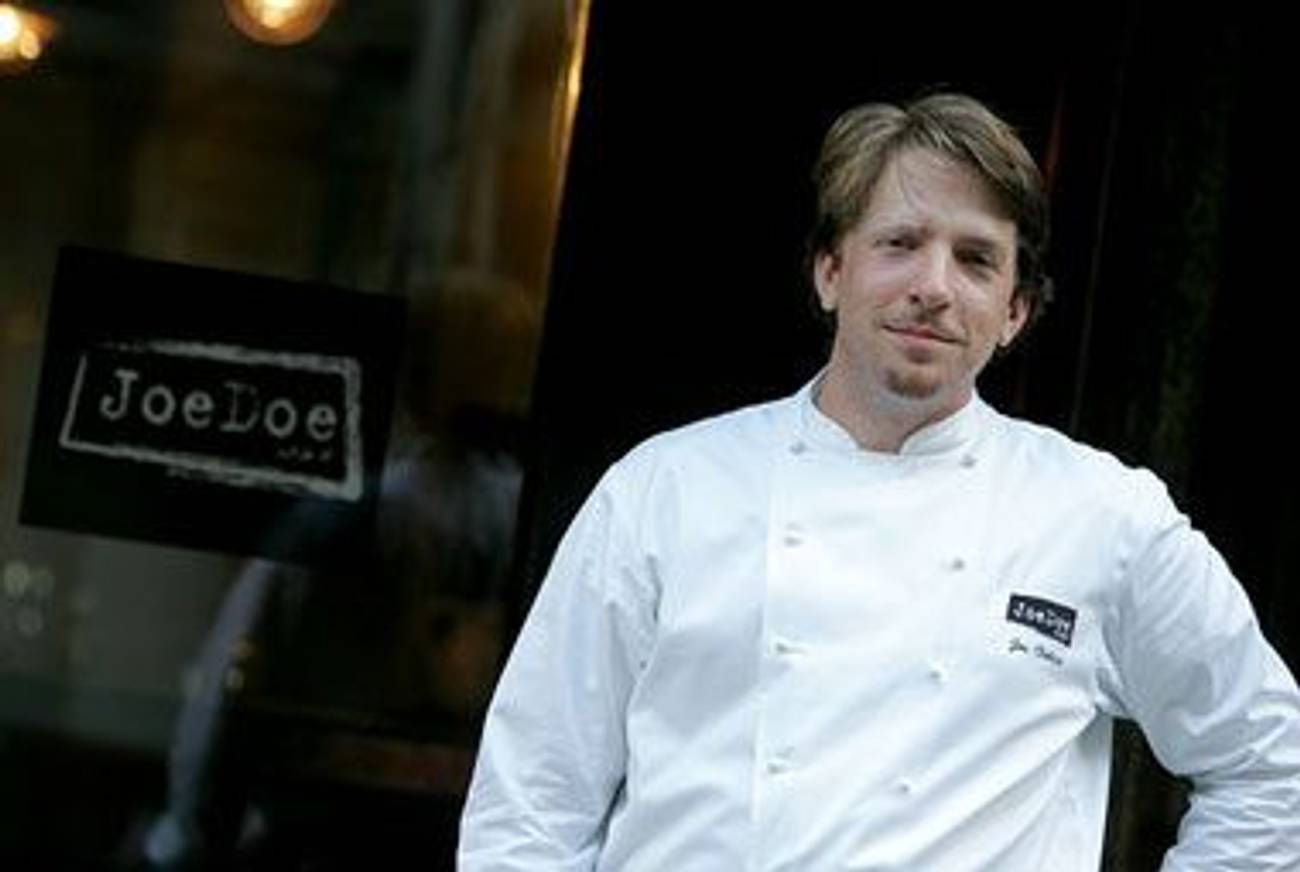Unkosher Cooking
New York chef Joseph Dobias is best known for the ‘Conflicted Jew’




Joseph Dobias’ tiny restaurant, JoeDoe, located on a quiet street in New York’s East Village, has exposed brick, wall-mounted family photos, and a jar full of wildflowers on the bar, making the place feel like a warm home kitchen. If not for a plaque announcing the restaurant’s status as Time Out New York’s “Best New Neighborhood Joint 2009,” a diner might be fooled into mistaking JoeDoe for another hole in the wall. But the menu tells another story. Next to natural Berkshire pork, nettle soup, and cured scallops are dishes that incorporate Ashkenazi and Sephardic flavors. As JoeDoe approaches its one-year anniversary, Dobias talks bout his enthusiasm for Jewish flavors and his distinctly unorthodox approach to fine dining.
You call your cuisine “aggressive American.” What role do Jewish flavors have in your cooking?
Because I’m not formally trained, I didn’t develop any rules about what can or can’t go into a dish. The way I cook is adaptive, and anything can find its way onto the menu. I’m not Jewish, but my girlfriend and restaurant partner, Jill, is, and I grew up in Long Island surrounded by Jewish cooking. I wasn’t conscious about putting Jewish influences on the menu; I had just been so immersed in those flavors that they seeped naturally into the food.
The place certainly has a Jewish feel, but we don’t approach food in the same way that midtown kosher restaurants do. There’s no rabbi in our dining room—one of the reasons people come to this restaurant is to escape the formality of the other places. That’s not to say this is a fusion restaurant; if you have a beet and a horseradish on a plate, I hold true to the traditional application for those vegetables. I’m not going to foam them.
You’ve celebrated one Passover—when kosher kitchens are thoroughly transformed—since opening the restaurant. Did you offer a holiday meal?
We planned an event to occur on the day before Passover, a kind of alternative to the traditional holiday. We called it the “Progressive Passover”—before you go home to family, we could have a night of food, fun music, and cocktails. That’s where we invented the Drunken Pharaoh, our Manischewitz-and-bourbon cocktail. We had matzo-ball soup, but we stuffed the matzo ball with foie gras. We also had what we called a Seder Sampler that included charoset, matzo, and chicken liver.
We didn’t expect the event to have much of an impact, but somehow the one-day event turned into three-day festival. Very few people approach Passover or any Jewish holiday in a secular manner—which isn’t to say we took the religion out of the holiday, but we made it approachable to everybody.
You also have a delicious matzo brei.
Our idea was to do a dessert version of the dish, since it’s usually seen as savory. Sometimes you see people adding cinnamon or syrup, but we took the idea a step further and added quark cheese, which is like cream cheese, golden raisins, and chocolate. It became a very dessert-y dish but with the familiar texture. We bring that back at brunch from time to time.
And your signature dish is “The Conflicted Jew.”
That was an accident—or rather, grew out of necessity. I originally had a chopped liver dish that I thought was going to be amazing, but no one liked it. I always had chopped liver left over—and also bacon and challah. One day we threw it all together in a sandwich for fun; I gave it the “Conflicted Jew” moniker. It’s become cultish; we get people requesting a “little more conflict” when they order.
What else on the menu incorporates Jewish influences?
Pastelicos, which have a Sephardic origin. They’re a precursor to the knish. We take mashed potatoes, dip them in egg yolk, and fry them up to get a skin on the outside. You wouldn’t necessarily associate the pastelito with a knish—the knish has a dough surrounding the filling—but the idea is exactly the same.
What other classics do you dream of tinkering with?
I’ve been trying to do kugel in an appetizing way. And gefilte fish. Those are two things with stereotypically bad reputations.
Any luck?
Still working on it. It’s difficult to overcome those bad reputations. Kugel is more of a winter dish, so we’ll revisit it then.
Molly Young is a writer in New York.